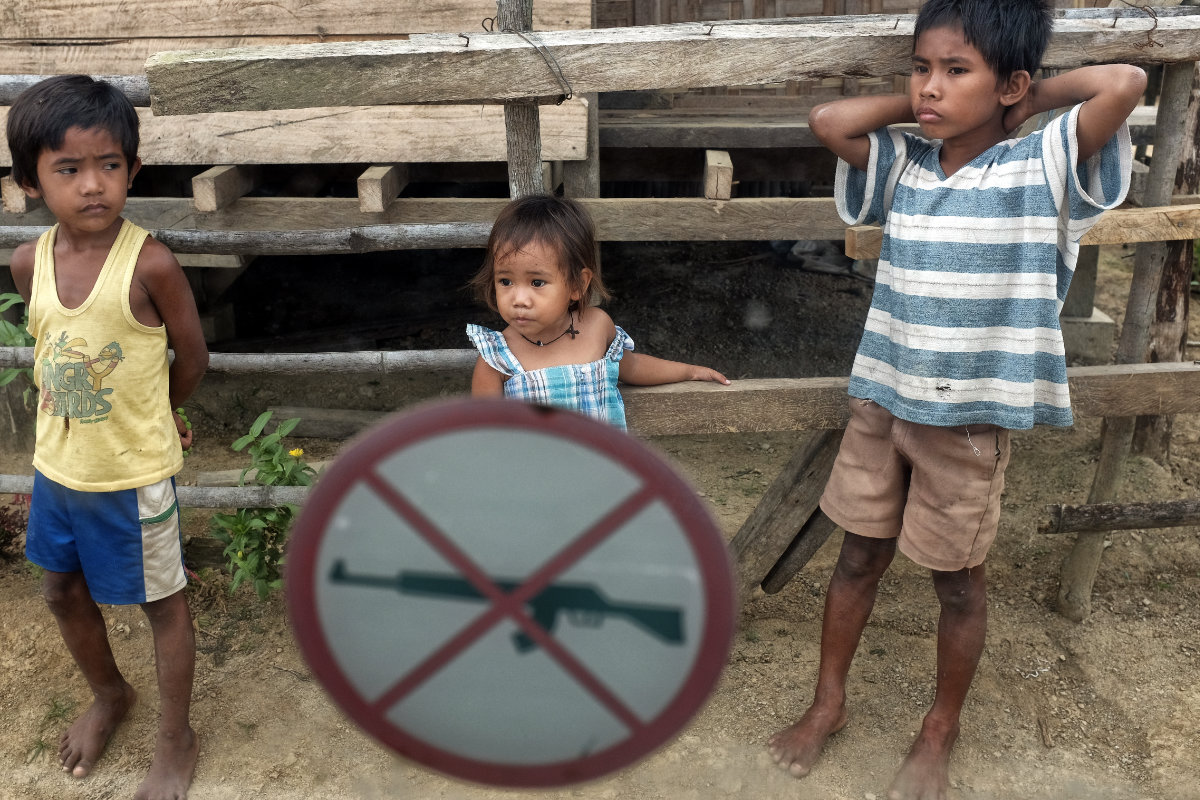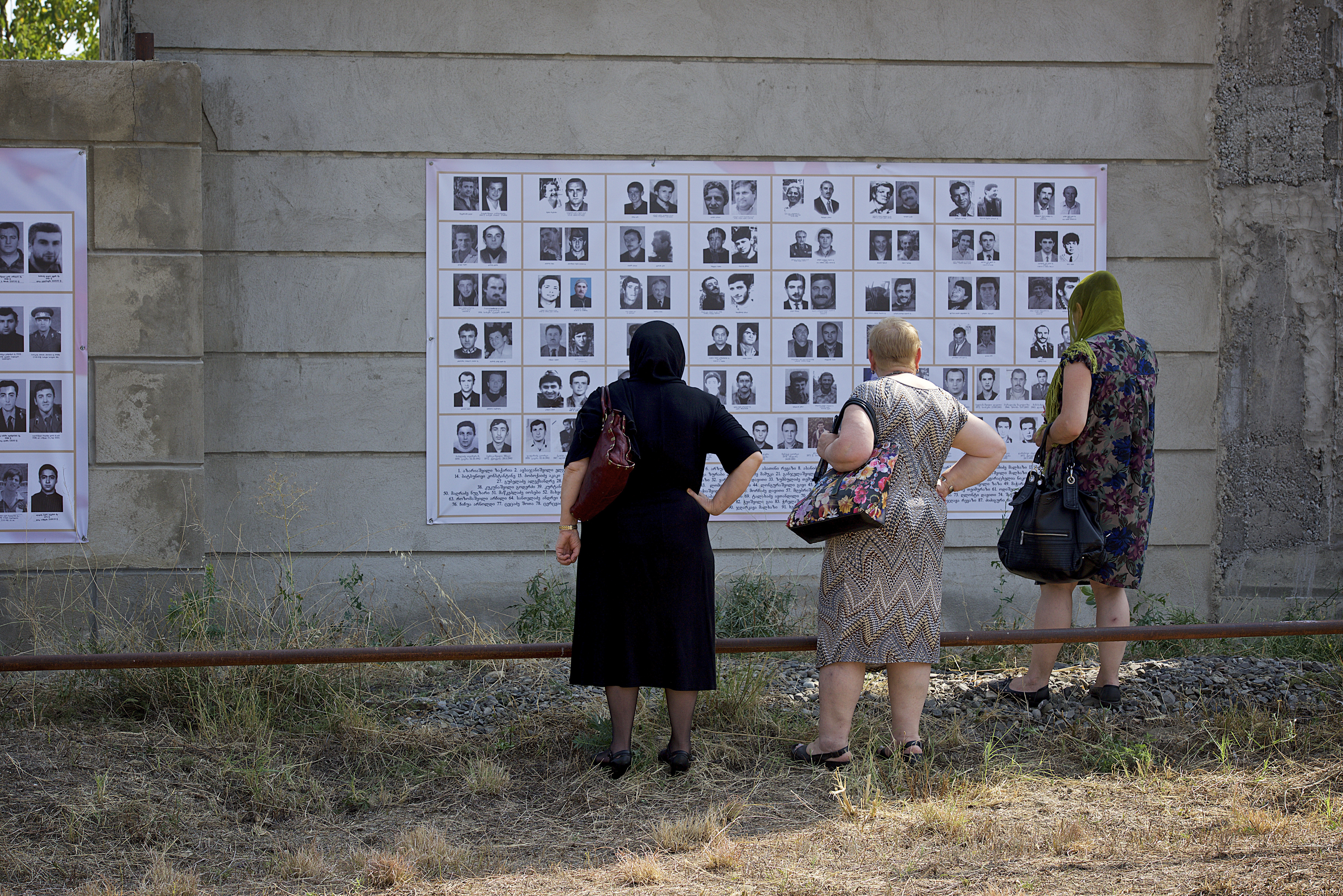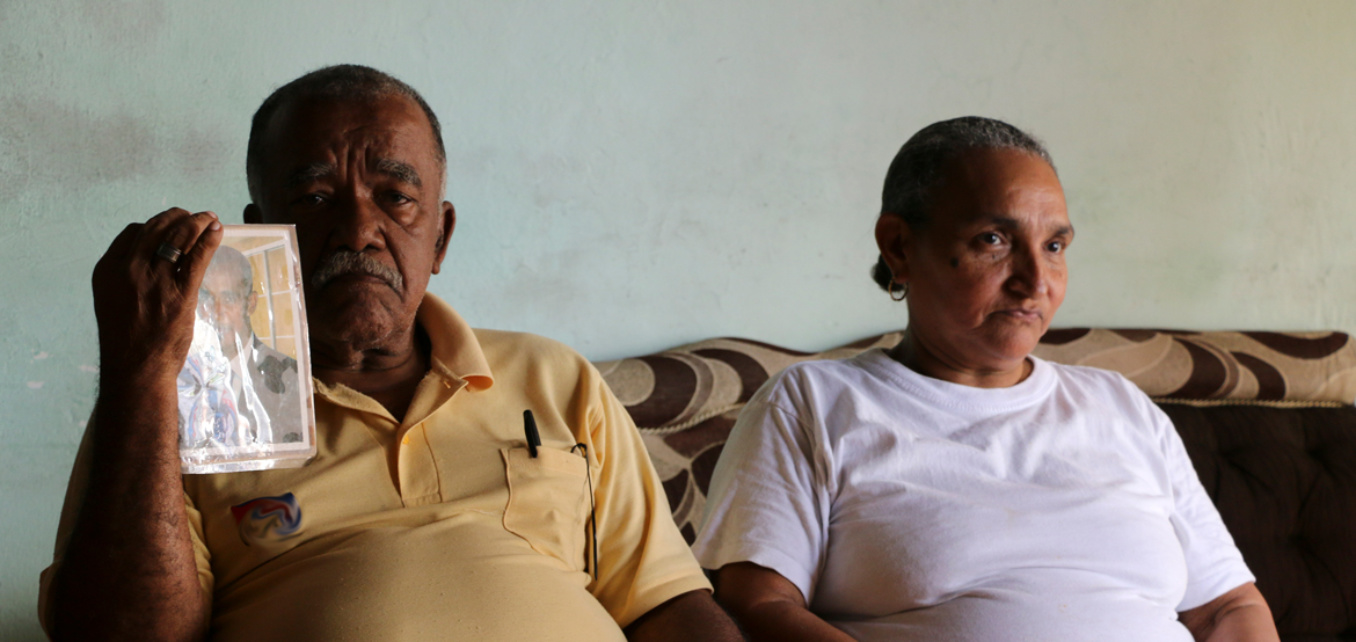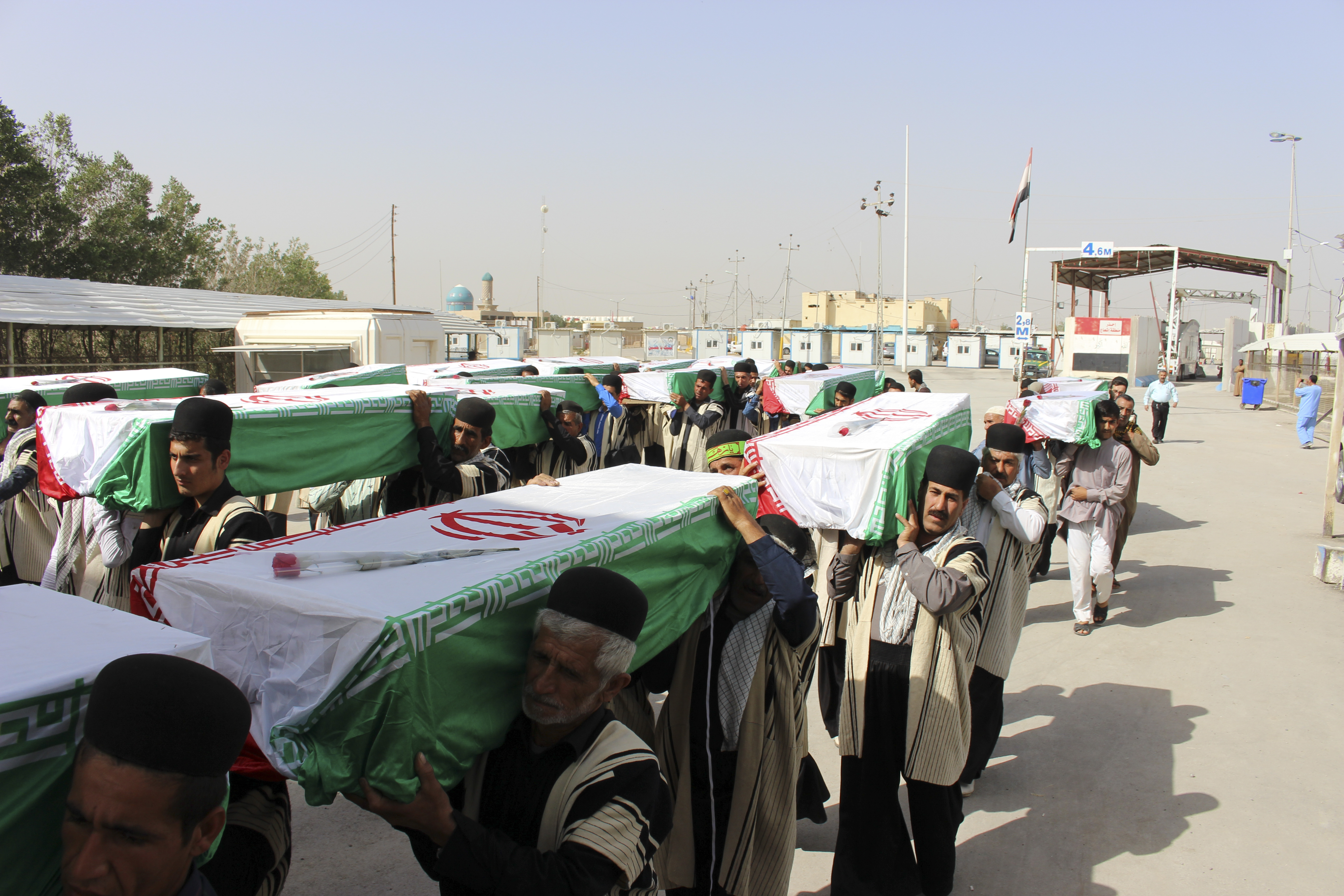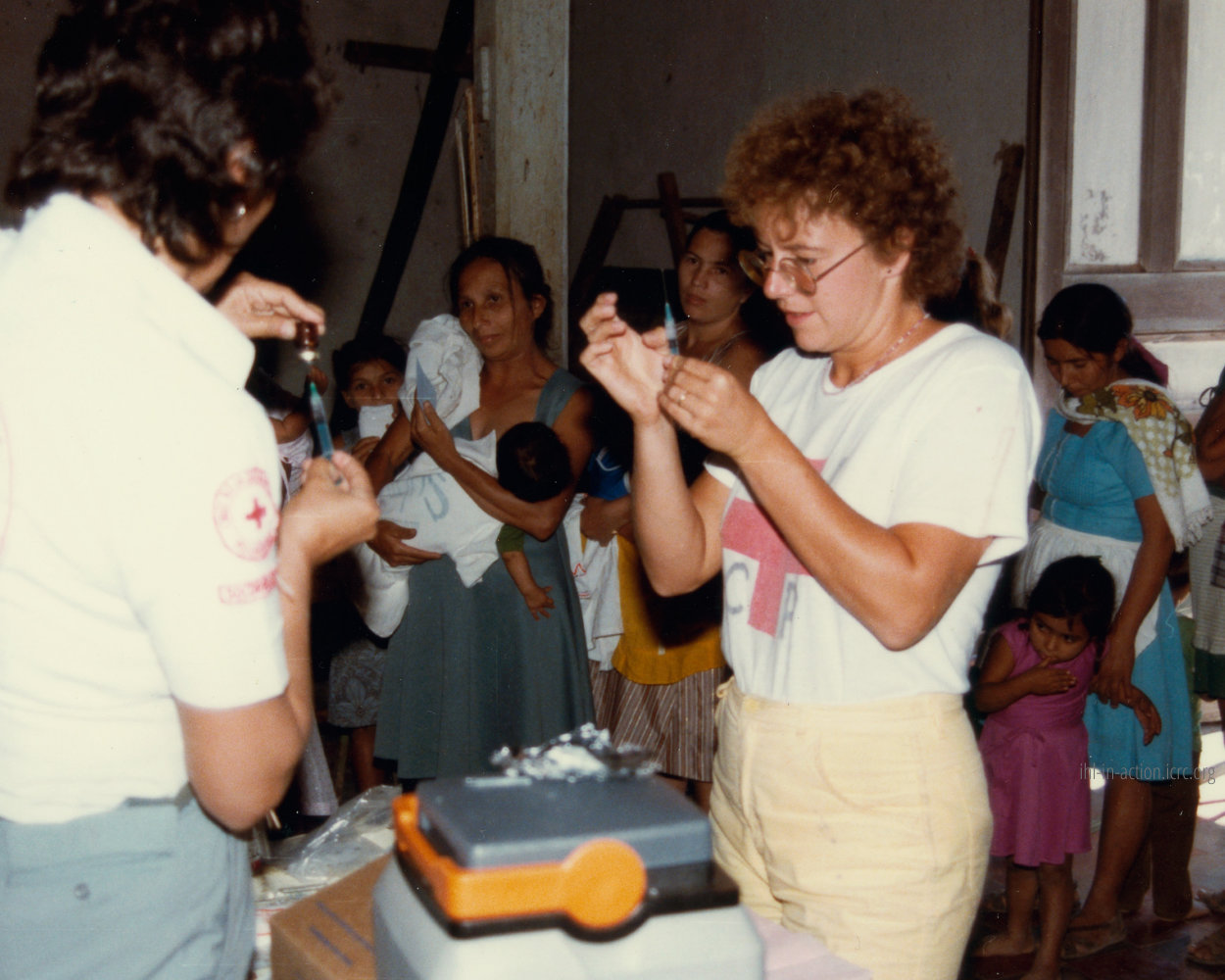
Facilitating safe access to immunizations for children in El Salvador: 1984–85
IHL Says
Basic international humanitarian law (IHL) rules applicable to this situation:
The parties to the conflict must allow and facilitate rapid and unimpeded passage of impartial humanitarian relief for all civilians in need, without any adverse distinction, subject to their right of control.
The parties to the conflict must ensure that authorized humanitarian relief personnel have the freedom of movement they need to carry out their work.
Children affected by armed conflict are entitled to special respect and protection.
The case in brief
Between 1980 and 1992 the Government of El Salvador and the Farabundo Martí National Liberation Front (FMLN), a non-state armed group, were engaged in armed conflict. By 1984, the impact of the fighting on health services had led to a crisis: unable to access routine healthcare, more than 40 per cent of children in conflict-affected areas were dying of preventable diseases.
Alerted to the crisis by the United Nations Children’s Fund (UNICEF) and religious leaders, the government and the FMLN paused hostilities on a series of dates to facilitate a national children’s vaccination campaign.
IHL compliance highlights
- Recognizing that the conflict was contributing to a rise in child mortality, and persuaded that children deserve special protection, both parties to the conflict agreed to cease hostilities on specific days in 1985 to facilitate three National Vaccination Days.
- With support from religious leaders, both parties explained the immunization programme’s importance to their field commanders, who instructed their troops to observe the ceasefires.
- To ensure families countrywide were aware of the initiative, the President of El Salvador personally launched a large-scale public information campaign, conducted with support from religious leaders and national and international organizations.
- On the designated dates, both parties honoured their agreement, allowing children and health teams safe passage to and from the vaccination sites. Health workers, volunteers and FMLN members administered the vaccinations. In total, 720,000 children under five years old received immunizations.
Case prepared by Laszlo Aust and June Goens, LL.M. students at Leiden University, under the supervision of Professor Robert Heinsch, as well Ashley Peltier with contributions from Alla Ershova (Senior Researchers), Emma Persson, James Patrick Sexton, and Eliza Walsh (Junior Supervisors), Kalshoven-Gieskes Forum, Leiden University.
A. EL SALVADOR AND FMLN COLLABORATE ON VACCINATION CAMPAIGN
[Source: UNICEF, ‘America’s Partnership With UNICEF: A report to the United States on the impact of its contribution to UNICEF from 1985 to 1995’, March 1997, p. 17, available at https://pdf.usaid.gov/pdf_docs/Pcaaa843.pdf]
[...] Our next visit takes us to see people who had been involved with programs for child survival during the war. First, we speak to Bishop Gregorio Rosa Chavez. Bishop Chavez worked with UNICEF, the Government and the FMLN to bring about cease-fires during the war so that children could be immunized. [...]
The Bishop tells us that in El Salvador, “Children opened the road for peace, because three times a year, beginning in 1985, the war was stopped for children. [...]”
“[...] Both sides at first thought it would be an advantage to the other. But once they looked at the proposal they agreed. That is because children are victims of war and have the right to live.” What was the condition of children in El Salvador at that time? “More than 43 percent of the children were dying of preventable diseases in the war zones; in some areas it was even higher.” [...]
[Source: Ciro A de Quadros and Daniel Epstein, ‘Health as a bridge for peace: PAHO’s experience’, The Lancet Supplement, Volume 360, December 2002, pp. 25-26, available at https://www.thelancet.com/pdfs/journals/lancet/PIIS0140-6736(02)11808-3.pdf]
[...] In El Salvador, at the height of the country’s civil conflict, 1-day truces were negotiated for immunisation against polio and other diseases, including diphtheria, whooping cough, tetanus, and measles. [...]
It took several months of critical discussions before “days of tranquility” were established for vaccination of children. A thorough briefing was given to guerrilla representatives on all issues related to the immunisation programme, eradication of polio, and the importance of everybody collaborating in this process. This information was then relayed to guerrilla field commanders so they could assess the situation and decide whether to agree to the cease-fires. Fortunately, there was agreement and the programmes proceeded. [...]
During the actual immunisation days, around 20 000 people—health workers, volunteers, and members of guerilla forces—gave the vaccinations. [...]
B. VACCINATIONS CARRIED OUT IN FEBRUARY, MARCH, AND APRIL OF 1985
[Source: Maggie Black (ed.), ‘Shots of a Peaceful Kind’, in UNICEF at 40: UNICEF News, Issue 123, 1986, p. 40, available at https://www.unicef.org/media/85536/file/UNICEF-at-40.pdf]
On three Sundays – February 3rd, March 3rd, April 21st, 1985 – the military and the rebel forces throughout El Salvador observed a truce for the sake of the children. Fighting stopped so that every mother, wherever she lived and under whosever control, could have safe passage to take her children to be immunized.
The mass vaccination campaign against the six childhood killers – diphtheria, whooping cough, tetanus, tuberculosis, measles, and polio – was backed by President José Napoleon Duarte. His instructions to government troops not to open fire followed assurances from Archbishop Rivera y Damas that the guerilla command would do likewise for the "days of tranquility".
The idea for the campaign grew out of a meeting at the office of UN Secretary-General Javier Perez de Cuellar in July 1984 between President Duarte and James Grant, Unicef’s Executive Director. Grant suggested that children's survival and health might be that rare cause which could command such widespread support that even a civil war could be put on hold. [...]
In the weeks before the campaign, posters and printed handbills announced dates for vaccination. Even lottery tickets carried the campaign emblem and the slogan: "prevenir es...vacunar". Thousands of advertisements were carried in newspapers and on the radio, and priests spoke to their congregations every Sunday on the duty of parents to "prevent by vaccination". The most complex problem was to make sure that everyone, even people in remote villages and war-torn districts, knew about the "days of tranquility". [...]
President Duarte himself launched the campaign on television, from the Presidential Palace, by taking in his arms the first small vaccination candidate. At his side were James Grant and Dr. Carlyle Guerrade Macedo, Director of PAHO [Pan American Health Organization]. Dr. Macedo said: "We are hopeful that this experience, in which health for children can serve as a bridge for peace, can be repeated throughout Central America." President Duarte then visited a number of health posts to see how the campaign was going. At the end of the day, he reported that no military actions had taken place to disrupt the immunization activities. Everyone had enjoyed a "day of peace, a day of hope". [...]
On the first "day", 217,000 children under five years old – a little more than half – came to be immunized. [...]
This [second] "day" turned out to be the most successful of all: 265,000 children were vaccinated. On the third, the total was 241,000. [...]
"This reconciliation for progress and the common good announced loudly El Salvador's commitment to a positive future and has been an inspiration to the rest of the world", wrote Javier Perez de Cuellar in a letter to President Duarte.
C. INTERNATIONAL COMMUNITY SUPPORTS EL SALVADOR AND FMLN’S VACCINATION CAMPAIGN
[Source: Expanded Program on Immunisation of the Pan American Health Organization, ‘EPI Newsletter: El Salvador Accelerates EPI’, Volume VII, Number 2, April 1985, pp. 1-2, available at https://iris.paho.org/bitstream/handle/10665.2/45355/sne0702.pdf?sequence=1&isAllowed=y]
[...] The success of National Vaccination Days has required the cooperation of international and national organizations including all political groups. Government forces and leftist guerrillas suspended hostilities during the vaccination days to allow health teams and the International Red Cross Society to enter areas of conflict. Not a single disruptive incident occurred at any of the vaccination posts, according to national press accounts.
The Catholic Church was instrumental in bringing about a suspension of hostilities during the two vaccination days. It also played a very important role in informing the people about the event by discussing the need for vaccination during Sunday church services.
In 2,132 vaccination posts, more than 6,000 individuals, health personnel as well as volunteers, who had all undergone a brief training period, quickly and efficiently attended the long lines of people. They administered the vaccines in the target age group and made available doses of tetanus toxoid to all women of child-bearing age in an attempt to reduce the incidence of neo-natal tetanus. [...]
Long range goals of the El Salvador National Vaccination Days are to reduce morbidity and mortality in the infant population and motivate the public to use routine immunization services. [...]
UNICEF, PAHO, USAID, Rotary International, and the Government of Spain, among others, provided material and technical support for the vaccination effort by supplying vaccines, syringes, administrative and technical personnel training, maintenance crews for the cold chain, printed materials, and technical support for the mass communication required in this event. [...]
Discussion
l. Classification of the Situation and Applicable Law
- How would you classify the situation in El Salvador when the vaccination campaign began in 1985? What additional information would you need to classify the situation? (GC I-IV, Art. 2, Art. 3; P I, Art. 1; P II, Art. 1)
- Which rules of IHL apply to humanitarian relief? Are these rules applicable both to international and non-international armed conflicts? Do these rules apply to both State and non-State actors? (GC IV, Art. 23; P I, Art. 70; P II, Art. 18; CIHL, Rule 55, Rule 56)
ll. Humanitarian Relief
- Who has an obligation under international humanitarian law to facilitate access to the civilian population for the purpose of providing humanitarian relief? Are these actors obliged to facilitate access for the purpose of vaccination campaigns? (P II, Art. 18; CIHL, Rule 55, Rule 56)
- Under what conditions may humanitarian organizations provide humanitarian relief to civilians? Is the consent of the respective State required for humanitarian actors to access its territory? Could humanitarian organisations have carried out the vaccination campaign without the consent of El Salvador? (P II, Art. 18; CIHL, Rule 55, Rule 56)
- In addition to the protection granted to the civilian population in general, what “special protections” are afforded to children under IHL? Do these specific protections support humanitarian relief for children? (P II, Art. 4; CIHL, Rule 135)
lll. Elements Contributing to Respect for IHL
- (Document B) Why might a campaign directed at children “command such widespread support that even a civil war could be put on hold”? In your opinion, why might relief efforts targeted at children in particular incentivize parties to armed conflicts to comply with IHL?
- (Documents A, Sources 1 and 2; Document B) In situations where there is both an ongoing armed conflict and a public health crisis, do you think parties would have a stronger motivation to grant access for humanitarian relief? To what extent could eliminating widespread diseases like polio or COVID-19, for example, induce parties to cease hostilities to facilitate humanitarian access?
- (Document B) “President Duarte himself launched the campaign on television, from the Presidential Palace, by taking in his arms the first small vaccination candidate.” How might this appearance have influenced the public’s opinion of President Duarte and the Government? In general, do you think public opinion can motivate parties to comply with IHL?
- (Document A, Source 1; Document B; and Document C) How might the role of external actors, such as international and national organizations, and religious leaders can influence parties to comply with IHL?

